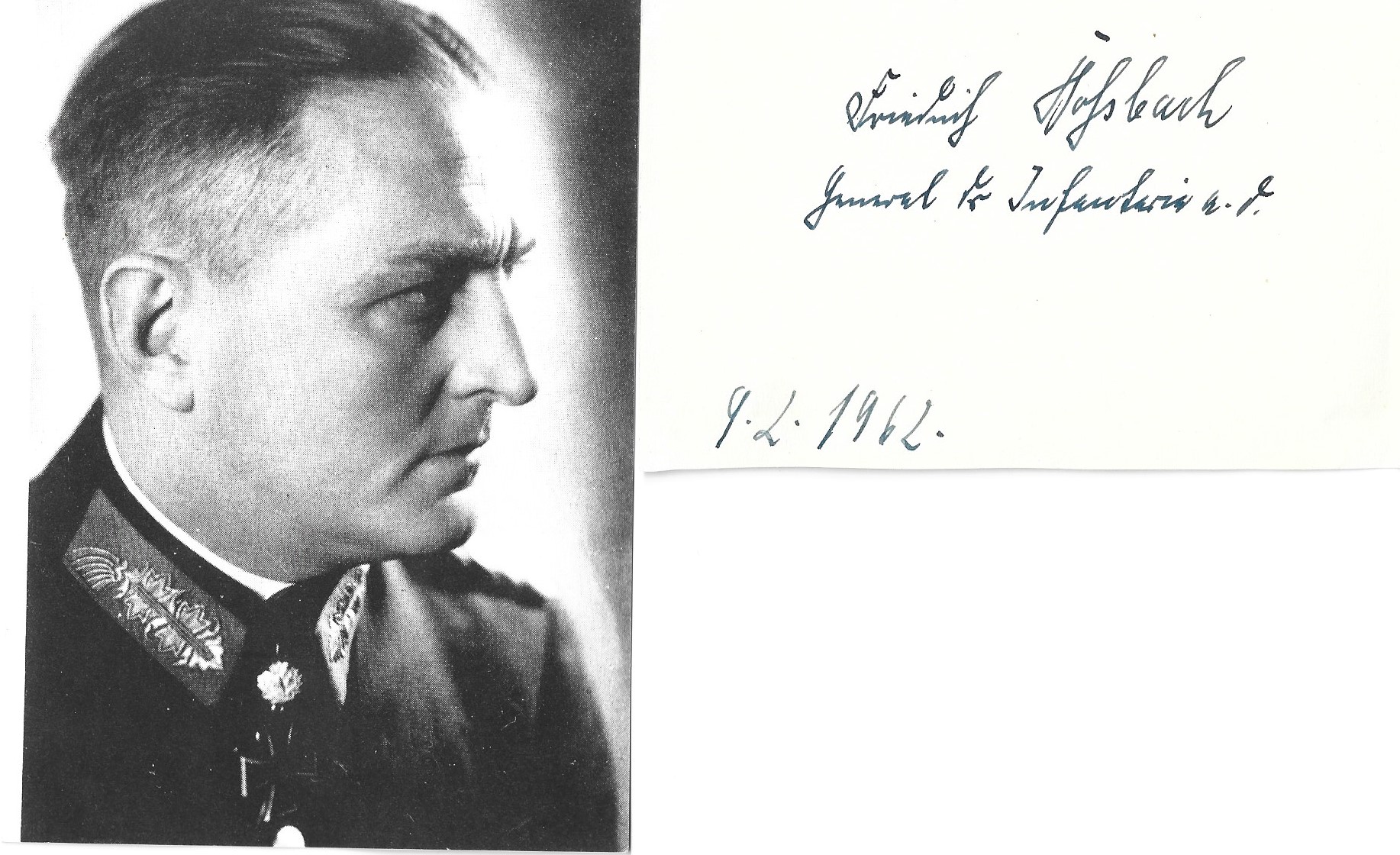
|
HOSSBACH Friedrich Wilhelm Ludwig
Generalleutnant
Hoßbach, Friedrich Wilhelm Ludwig
*November 21st, 1894 (Unna/Westernphalia, Germany)
+September 10th, 1980 (Göttingen/Lower Saxony, Germany)
Knights Cross: October 7th, 1940
As: Oberst Kommandeur Infanterie-Regiment 82 / 31.Infanterie-Division / II.Armee-Korps / 6.Armee
On the 12.06.1940, a patrol leader reported to Oberst Hoßbach that Allied troops were embarking on ships along the coast west of Dieppe. Accompanied by another officer, Hoßbach rushed to the scene with some soldiers in his vehicle. At the beach he found a large amount of English and French soldiers trying to get to their transports by swimming or using barges. Hoßbach swiftly brought up a Pak Zug and this took the transports under fire, the latter quickly fleeing the scene. As a result the Germans were able to capture the 4200 English and French soldiers (including 82 officers) who had been left behind, as well as a large quantity of materiel.
Later, on the 19.06.1940, Hoßbach commanded a Vorausabteilung of his Division during a 250 km trek to the Loire river in order to seize a bridgehead over it near Florent le Vieil. They penetrated into the city and were able to prevent the destruction of the large Mayenne bridge, which had been prepped for demolition beforehand by the Allies.
Hoßbach would receive the Knight’s Cross for the sum of his successes during the French campaign.
227th Award.
Oakleaves: September 11th, 1943
As: Generalleutnant Führer LVI.Panzerkorps / 2.Armee / Heeresgruppe Mitte
Hoßbach took over acting command of the LVI. Panzer-Korps on the 15.08.1943 and with this unit distinguished himself during combat near Spass-Demensk, along the Desna and at Gomel. For his leadership of the unit throughout these engagements he would be awarded the Oakleaves to his Knight’s Cross.
298th Award.
Shortly before the outbreak of the Second World War, Hoßbach joined the General Staff of the XXX Army Corps on 26 August 1939 as its chief and on 30 September 1939 in the same capacity to the II Army Corps. On 1 December 1939, he regained command of Infantry Regiment 82 and led it during the Western Campaign.
On 24 February 1942, Hossbach was transferred to the Fuehrer Reserve for the first time, where he was promoted to Major General on 1 March. He was given command of the 82nd Infantry Division on 1 April and was again transferred to the Fuehrer Reserve from 1 September 1942 to 15 May 1943. Promoted to lieutenant general, Hossbach took over the 31st Infantry Division on 15 May 1943, was given command of the LVI Panzer Corps on 2 August 1943 and was appointed commanding general of the corps on 10 August. In this position, he was promoted to General of Infantry on 1 November 1943.
On the occasion of his fiftieth birthday, on November 21, 1944, Friedrich Hoßbach received a tax-free endowment of 50,000 Reichsmarks from Hitler.
From 18 July 1944 he was commander-in-chief of the 4th Army and was personally dismissed by Hitler on 29 January 1945 during the Battle of East Prussia because he had wanted to order the breakout from the encircled East Prussia against the express order.
Towards the end of the war, Hossbach was treated for an ear infection at the Göttingen University Hospital. On April 8, 1945, shortly before the arrival of the U.S. Army, he was warned that the Gestapo would pick him up. When the doorbell rang, he went out onto the balcony with his pistol and engaged in a firefight with the waiting Gestapo officers – a uniformed man and two plainclothes policemen – as well as a member of the SS, until his opponents – obviously afraid of the advancing US army – fled by car. Less than an hour later, the Americans arrived, who captured him. He remained a prisoner of war until 1947.
Postwar signature on paper dated 9.2.1962 measuring 3 ½” x 5” with unsigned photo . This came from the author Dermot Bradley’s collection
Price: $40.00
Please contact us before ordering to confirm availability and shipping costs.
Buy now with your credit card
other ways to buy
|


